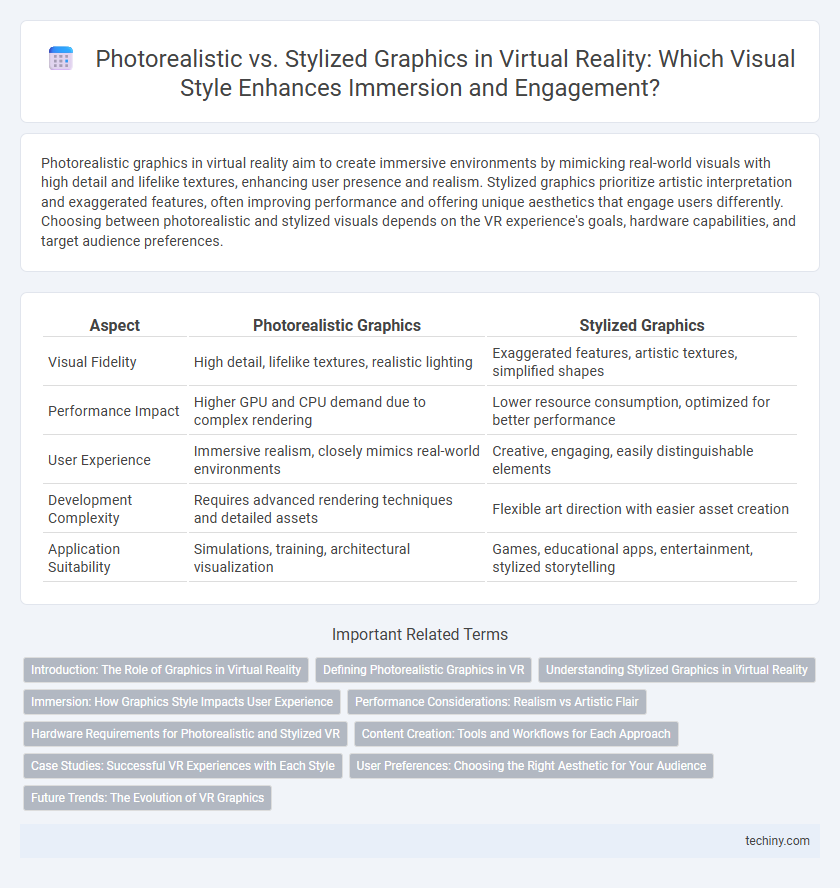Photorealistic graphics in virtual reality aim to create immersive environments by mimicking real-world visuals with high detail and lifelike textures, enhancing user presence and realism. Stylized graphics prioritize artistic interpretation and exaggerated features, often improving performance and offering unique aesthetics that engage users differently. Choosing between photorealistic and stylized visuals depends on the VR experience's goals, hardware capabilities, and target audience preferences.
Table of Comparison
| Aspect | Photorealistic Graphics | Stylized Graphics |
|---|---|---|
| Visual Fidelity | High detail, lifelike textures, realistic lighting | Exaggerated features, artistic textures, simplified shapes |
| Performance Impact | Higher GPU and CPU demand due to complex rendering | Lower resource consumption, optimized for better performance |
| User Experience | Immersive realism, closely mimics real-world environments | Creative, engaging, easily distinguishable elements |
| Development Complexity | Requires advanced rendering techniques and detailed assets | Flexible art direction with easier asset creation |
| Application Suitability | Simulations, training, architectural visualization | Games, educational apps, entertainment, stylized storytelling |
Introduction: The Role of Graphics in Virtual Reality
Graphics in virtual reality define user immersion by shaping the realism and artistic style of the environment. Photorealistic graphics strive to replicate real-world visuals with high fidelity, enhancing presence and spatial awareness. Stylized graphics use artistic interpretations to convey mood or narrative, often optimizing performance while encouraging imaginative engagement.
Defining Photorealistic Graphics in VR
Photorealistic graphics in VR aim to replicate real-world visuals with high fidelity, incorporating accurate lighting, textures, and detailed models to create immersive environments. These graphics rely on advanced rendering techniques such as ray tracing, global illumination, and high-resolution textures to enhance realism. The goal is to achieve a seamless visual experience that mimics reality, enhancing user presence and immersion within the virtual space.
Understanding Stylized Graphics in Virtual Reality
Stylized graphics in virtual reality emphasize artistic expression over realistic representation, using exaggerated shapes, vibrant colors, and unique textures to create immersive environments that evoke emotion and imagination. This approach enhances user engagement by simplifying complex visuals, reducing cognitive load, and allowing for faster rendering, which is critical in maintaining high performance and low latency in VR systems. Developers leverage stylized graphics to produce memorable experiences that stand out from photorealistic visuals while supporting creative storytelling and accessibility.
Immersion: How Graphics Style Impacts User Experience
Photorealistic graphics in virtual reality enhance immersion by creating lifelike environments that closely mimic real-world visuals, increasing user presence and engagement. Stylized graphics prioritize artistic expression and can evoke unique emotional responses, fostering imaginative interaction without the constraints of realism. The choice between photorealistic and stylized styles significantly impacts user experience, with the former emphasizing authenticity and the latter promoting creativity and distinct narrative atmospheres.
Performance Considerations: Realism vs Artistic Flair
Photorealistic graphics in virtual reality demand high computational power, often requiring advanced GPUs and increased rendering time to achieve realistic lighting, textures, and depth, which can impact frame rates and user comfort. Stylized graphics prioritize artistic flair with simplified textures and exaggerated features, significantly reducing processing load and enabling smoother performance on lower-end VR systems. Balancing realism and performance involves assessing hardware capabilities and user experience goals, as photorealism enhances immersion while stylization supports accessibility and responsiveness.
Hardware Requirements for Photorealistic and Stylized VR
Photorealistic VR graphics demand significantly higher hardware capabilities, requiring advanced GPUs with substantial VRAM, such as NVIDIA RTX 3080 or higher, to render intricate textures and realistic lighting in real time. Stylized VR graphics generally have lower hardware requirements, allowing smoother performance on mid-range GPUs like the NVIDIA GTX 1660, due to simplified textures and less complex shading. Memory bandwidth and processing power are critical for photorealistic VR, impacting frame rates and latency, whereas stylized VR prioritizes optimization and efficient rendering pipelines to maintain immersion on broader hardware configurations.
Content Creation: Tools and Workflows for Each Approach
Photorealistic VR content creation relies heavily on advanced rendering engines like Unreal Engine and Unity with ray tracing capabilities, demanding high-resolution textures and detailed 3D modeling workflows to achieve lifelike visuals. Stylized VR content benefits from creative tools such as Blender and Substance Painter, which support hand-painted textures and exaggerated geometries, enabling faster iteration and unique artistic expression. Both approaches require specialized pipelines tailored to their visual goals, with photorealistic workflows emphasizing realism and fidelity, while stylized workflows focus on distinct aesthetics and efficient asset production.
Case Studies: Successful VR Experiences with Each Style
Photorealistic graphics in VR, exemplified by Oculus' *The Climb 2*, deliver immersive realism through high-definition textures and lifelike lighting, enhancing user presence and engagement in natural environments. Conversely, stylized graphics like those in *Beat Saber* utilize vibrant colors and simplified forms, fostering intuitive gameplay and broad accessibility while maintaining strong artistic identity. Both approaches demonstrate successful VR experiences by aligning visual style with target audience preferences and interaction design goals.
User Preferences: Choosing the Right Aesthetic for Your Audience
User preferences in Virtual Reality graphics significantly influence engagement, with photorealistic visuals appealing to audiences seeking immersive, life-like experiences and stylized graphics favored by those appreciating artistic expression and creativity. Studies indicate that photorealism enhances presence and realism, ideal for training simulations and architectural visualizations, while stylized aesthetics boost emotional connection and accessibility in gaming and educational content. Understanding your target audience's expectations and the context of use is crucial for selecting the appropriate graphic style that maximizes user satisfaction and immersion.
Future Trends: The Evolution of VR Graphics
Photorealistic graphics in VR are advancing rapidly with ray tracing and AI-driven rendering, enabling ultra-realistic environments that enhance immersion and user presence. Stylized graphics remain vital for artistic expression and performance optimization on diverse VR hardware, supporting unique experiences and broader accessibility. Future trends indicate a hybrid approach where photorealism and stylization merge, leveraging real-time adaptive graphics to balance realism, interactivity, and creative aesthetics in evolving VR landscapes.
Photorealistic vs Stylized Graphics Infographic

 techiny.com
techiny.com